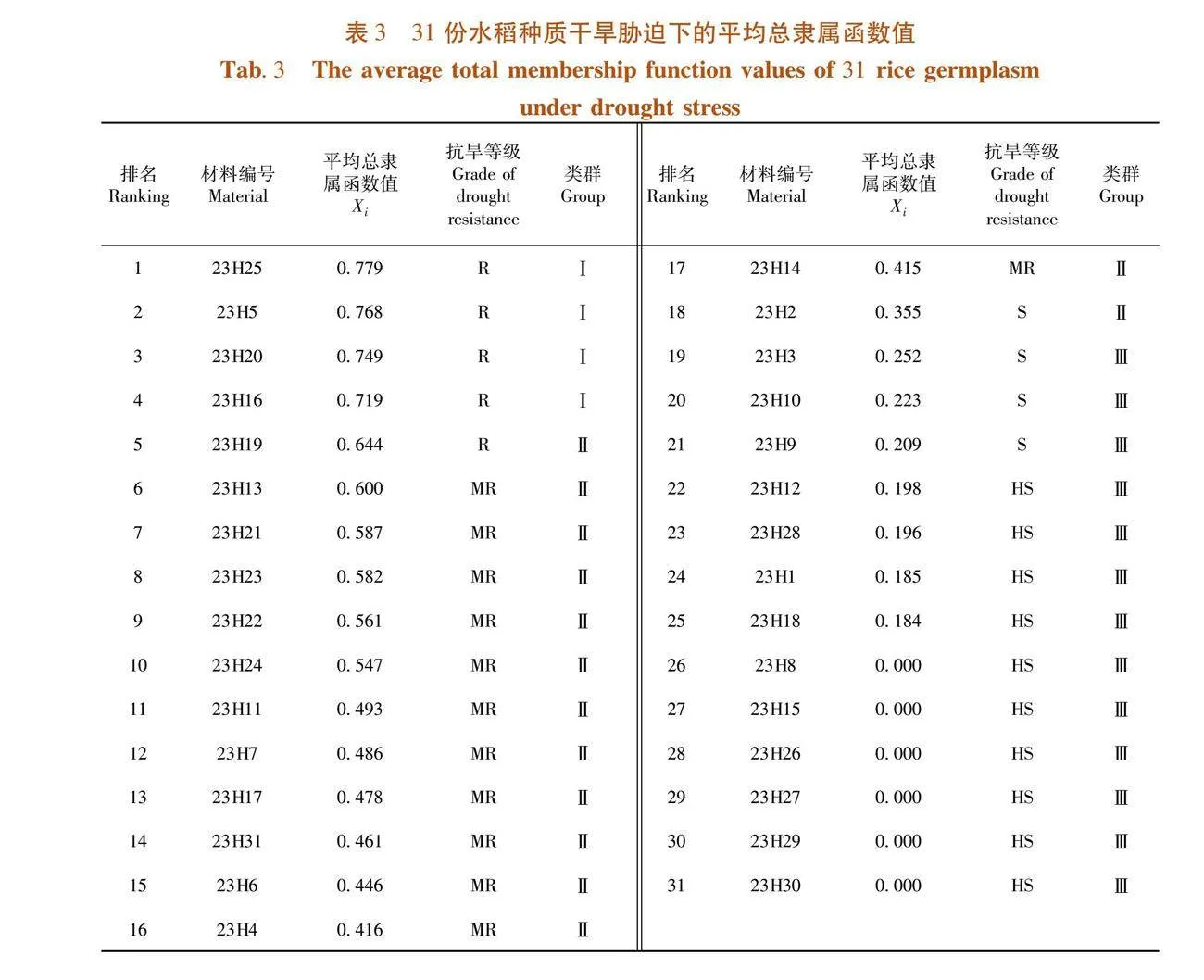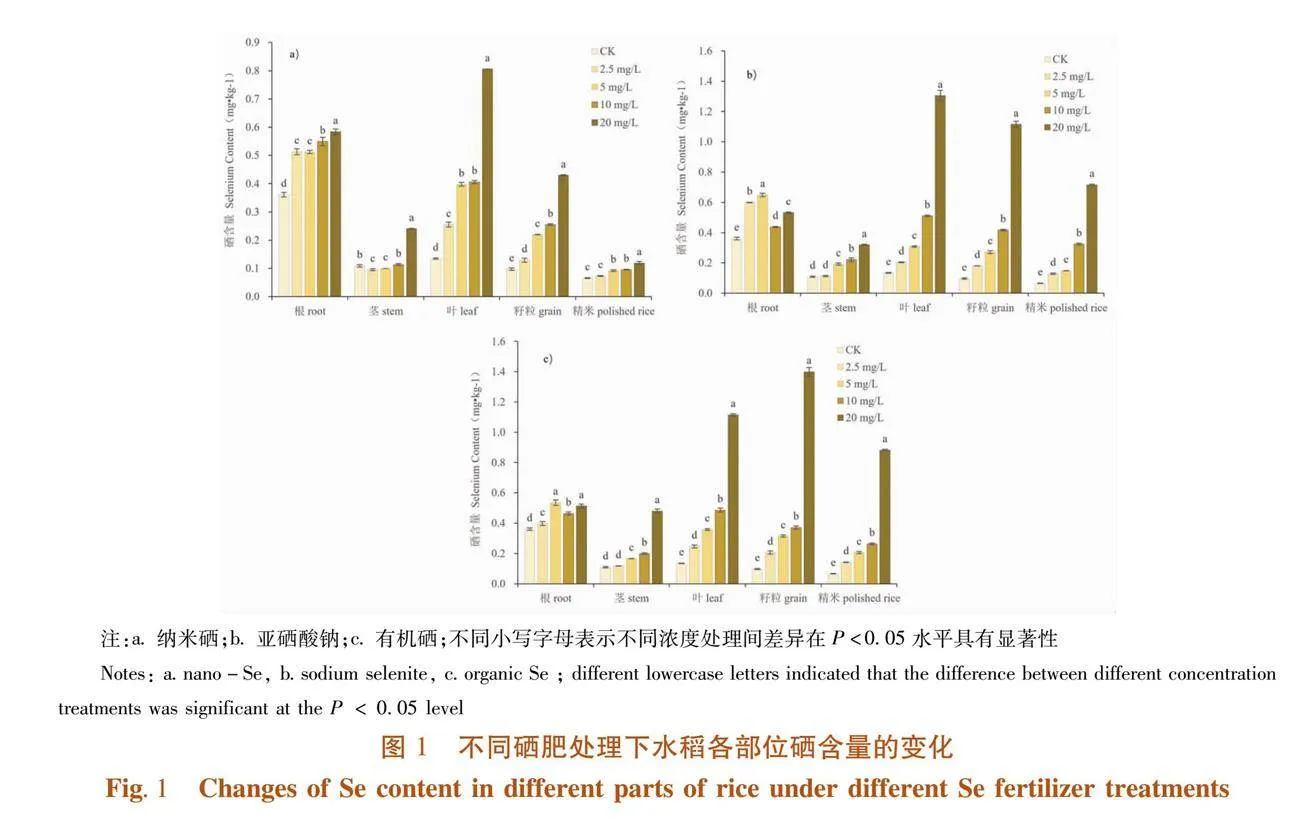
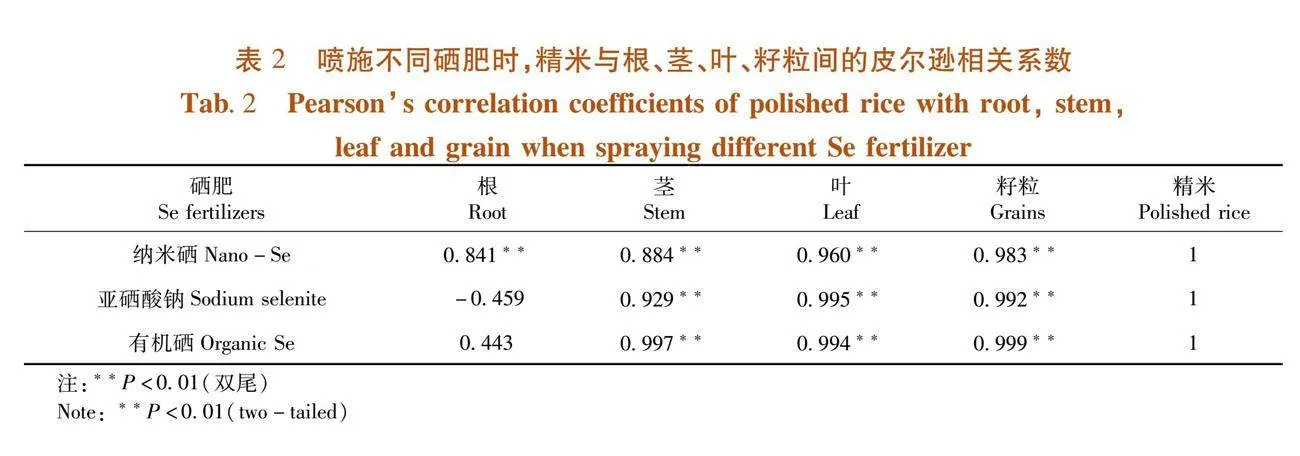
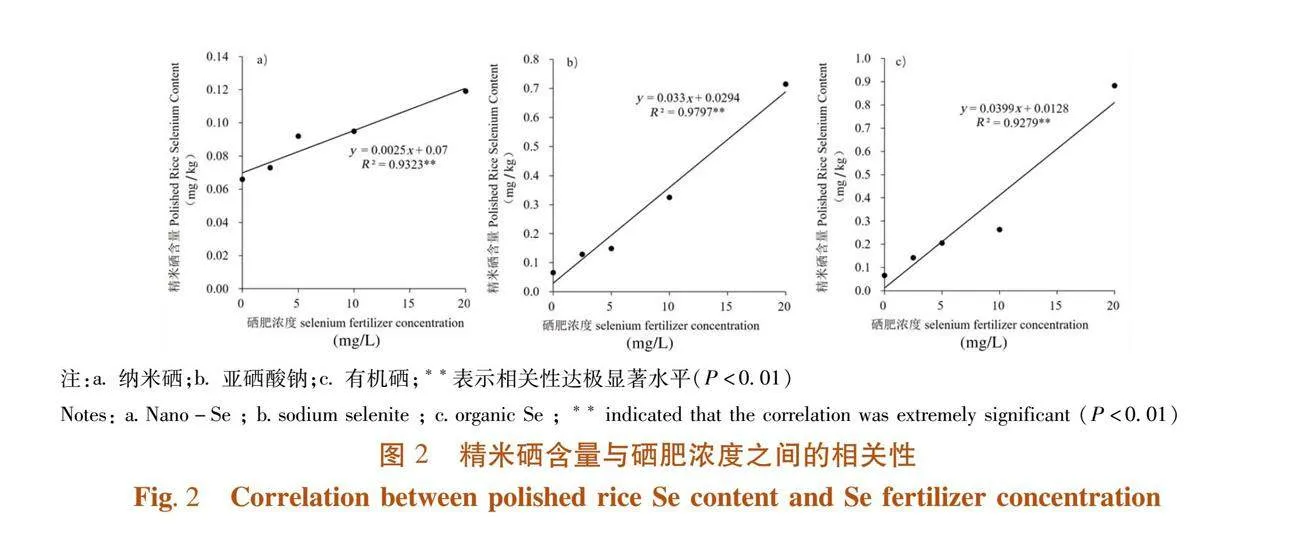
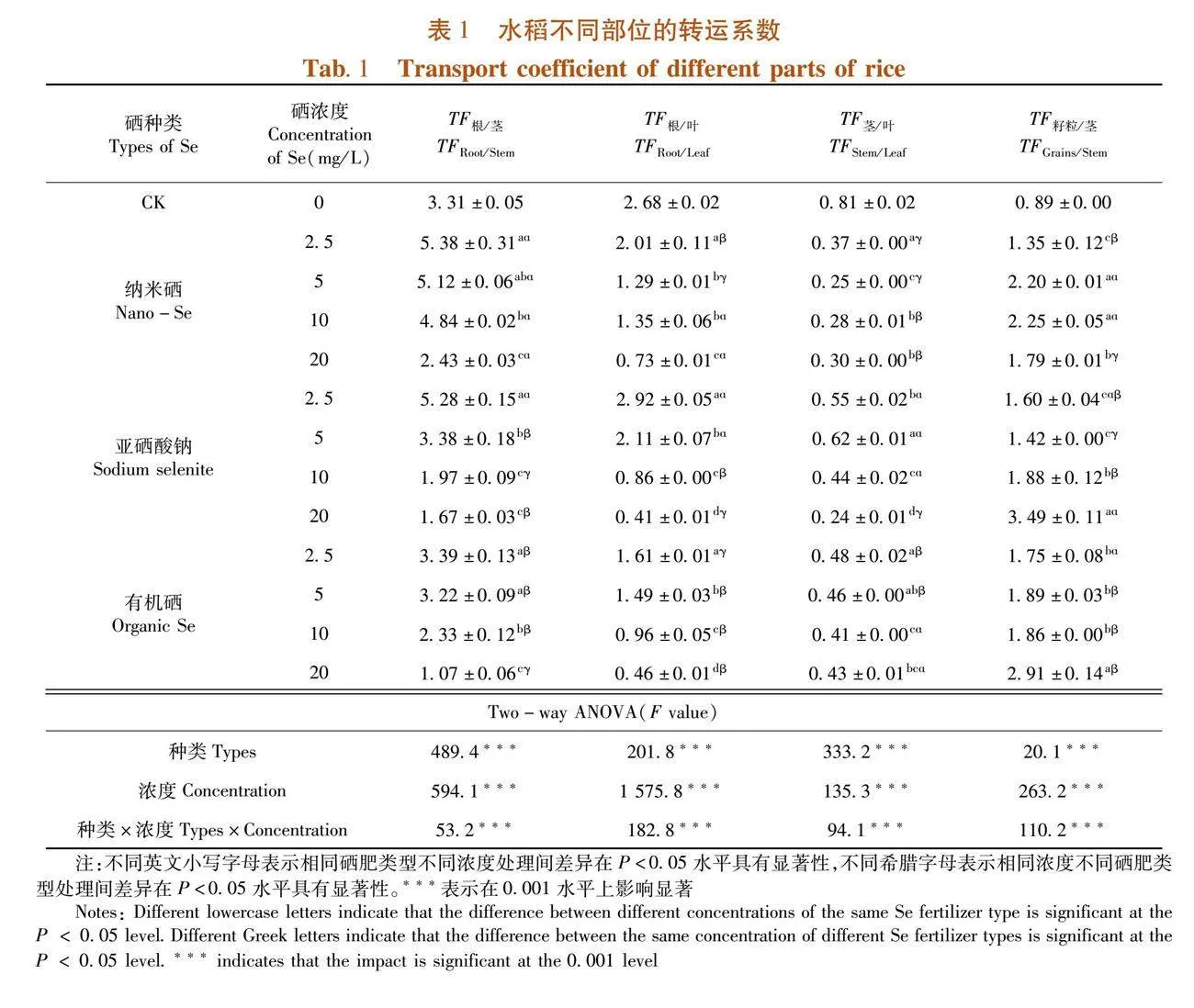
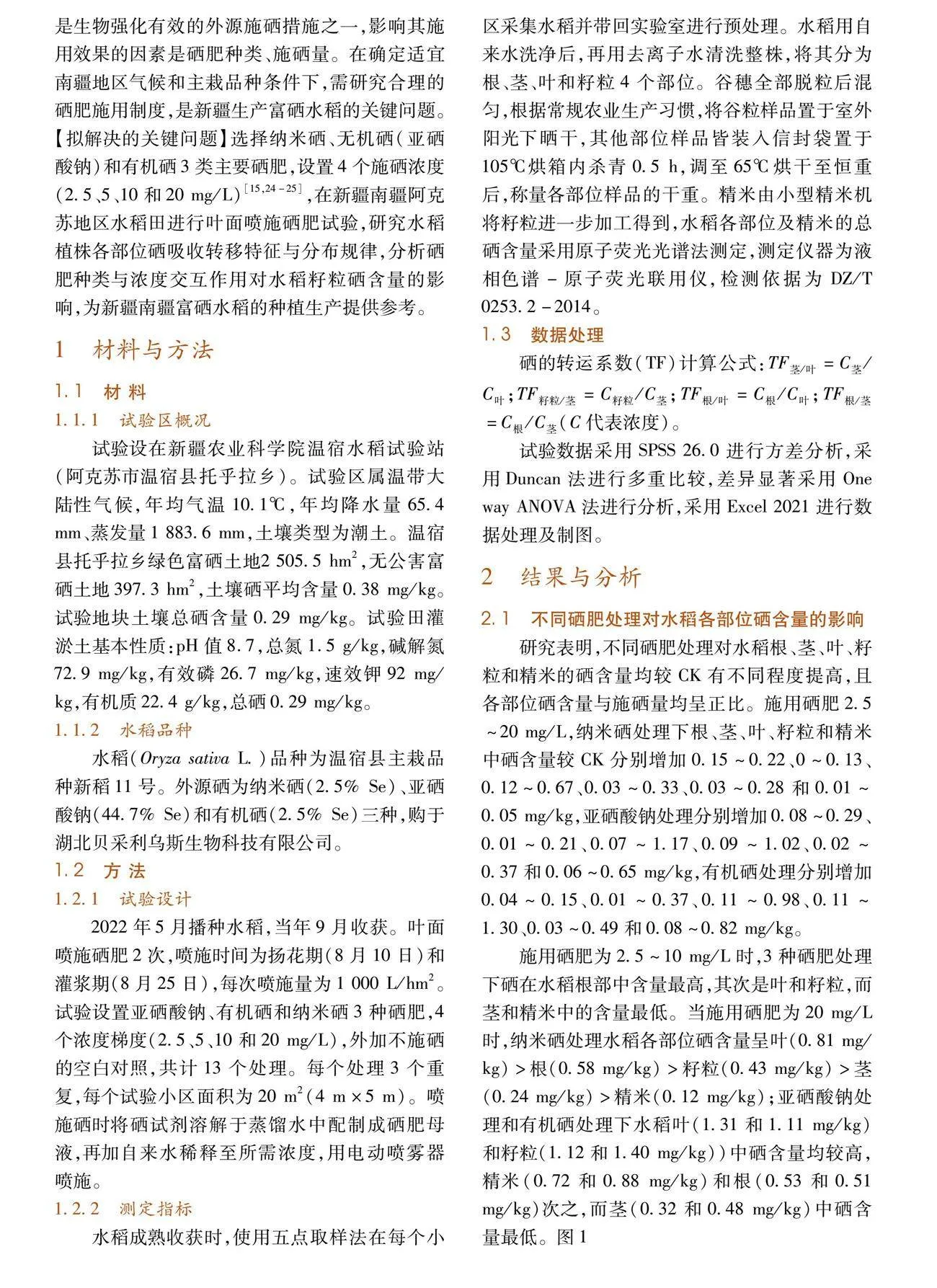
摘 要:【目的】研究新疆南疆气候条件下水稻主栽品种喷硒肥的吸收转移特征,分析硒肥种类与浓度交互作用对水稻籽粒硒含量的影响,为新疆南疆富硒水稻的种植生产提供理论依据。
【方法】以新疆南疆阿克苏地区主栽水稻品种新稻11号为材料,采用纳米硒、亚硒酸钠和有机硒类的硒肥,设置2.5、5、10和20 mg/L 4个喷施浓度的组合试验,研究叶面喷施硒肥对水稻植株硒吸收和转运的影响。
【结果】硒肥处理均可显著提高稻米中的硒含量。籽粒、精米、叶片和茎部中的硒含量均随硒肥浓度的增加而提高;3种硒肥对稻米的富硒效果为有机硒gt;亚硒酸钠gt;纳米硒。喷施纳米硒肥时大部分硒积累在谷壳和米糠中,精米中的硒含量提高较少,而喷施有机硒和亚硒酸钠则使籽粒或精米的硒含量均显著提高。
【结论】20 mg/L的有机硒和亚硒酸钠对水稻硒生物强化的效果最佳,使精米硒含量分别提高到0.88和0.72 mg/kg。
关键词:外源硒;水稻;吸收;转运;硒生物强化
中图分类号:S511 ""文献标志码:A ""文章编号:1001-4330(2025)01-0103-07
收稿日期(Received):
2024-05-10
基金项目:
新疆维吾尔自治区重点研发计划项目“南疆富硒农产品关键技术研究及应用示范”(2022B03008-3)
作者简介:
凌沥(1998-),男,四川大竹人,硕士研究生,研究方向为生态工程,(E-mail)2467419517@qq.com
通信作者:
翟辉(1992-),女,内蒙古人,副教授,博士,研究方向为土壤金属的迁移转化,(E-mail)zhaihui@xju.edu.cn
张云舒(1975-),女,新疆人,副研究员,研究方向为农业废弃物利用,(E-mail)zhangxl1994@sina.com
0 引 言
【研究意义】硒是一种对人体和动物均十分重要的微量元素[1-3],施用外源硒肥是硒生物强化的主要措施,近年来叶面喷施外源硒已有相关研究。通过叶面喷施硒肥,硒元素可以直接供给到水稻叶片,相比土壤施硒能够减少硒肥损失提高利用率[4,5],且避免了硒通过土壤淋溶迁移而产生的环境问题[6]。植物对硒的吸收和积累与外源硒的种类和浓度密切相关。【前人研究进展】目前常见硒肥主要为无机硒肥(硒酸盐和亚硒酸盐)和有机硒肥(氨基酸螯合型硒肥、腐植酸型硒肥等)[7]。叶面喷施硒酸盐和亚硒酸盐均可显著提高水稻籽粒的硒含量,且亚硒酸盐的效果显著优于硒酸盐[8-11]。喷施有机硒肥也能使水稻达到很好的富硒效果[7,12-15]。与此同时,硒纳米颗粒具有生物活性高、细胞毒性低、比表面积大等特性,且可以被植物吸收转运并同化为其它形态的硒,因此纳米硒肥的应用前景也有文献探究[10,16,17]。适宜的硒肥施用量能够有效地增加水稻的硒含量,但如果施用的硒肥量过高,则会对水稻的生长发育产生负面影响[18-20]。
新疆天然富硒土壤主要分布于巴音郭楞蒙古自治州焉耆回族自治县和博湖县、阿克苏地区温宿县及新疆生产建设兵团第二师30团,总面积约0.93×104 hm2(14×104亩)[21,22],新疆水稻在上述区域均有种植。张栋等[23]研究发现,在新疆水稻主产区(包括南疆)44个稻田的土壤中,可被水稻吸收的土壤有效硒含量较低(平均值为0.054 mg/kg),80%的水稻籽粒未达富硒水稻国家标准(0.04 mg/kg),在富硒土壤仍需进行外源硒生物强化提升水稻籽粒硒含量。【本研究切入点】叶面施硒是生物强化有效的外源施硒措施之一,影响其施用效果的因素是硒肥种类、施硒量。在确定适宜南疆地区气候和主栽品种条件下,需研究合理的硒肥施用制度,是新疆生产富硒水稻的关键问题。【拟解决的关键问题】选择纳米硒、无机硒(亚硒酸钠)和有机硒3类主要硒肥,设置4个施硒浓度(2.5、5、10和20 mg/L)[15,24-25],在新疆南疆阿克苏地区水稻田进行叶面喷施硒肥试验,研究水稻植株各部位硒吸收转移特征与分布规律,分析硒肥种类与浓度交互作用对水稻籽粒硒含量的影响,为新疆南疆富硒水稻的种植生产提供参考。
1 材料与方法
1.1 材 料
1.1.1 试验区概况
试验设在新疆农业科学院温宿水稻试验站(阿克苏市温宿县托乎拉乡)。试验区属温带大陆性气候,年均气温10.1℃,年均降水量65.4 mm、蒸发量1 883.6 mm,土壤类型为潮土。温宿县托乎拉乡绿色富硒土地2 505.5 hm2,无公害富硒土地397.3 hm2,土壤硒平均含量0.38 mg/kg。试验地块土壤总硒含量0.29 mg/kg。试验田灌淤土基本性质:pH值8.7,总氮1.5 g/kg,碱解氮72.9 mg/kg,有效磷26.7 mg/kg,速效钾92 mg/kg,有机质22.4 g/kg,总硒0.29 mg/kg。
1.1.2 水稻品种
水稻(Oryza sativa L.)品种为温宿县主栽品种新稻11号。外源硒为纳米硒(2.5% Se)、亚硒酸钠(44.7% Se)和有机硒(2.5% Se)三种,购于湖北贝采利乌斯生物科技有限公司。
1.2 方 法
1.2.1 试验设计
2022年5月播种水稻,当年9月收获。叶面喷施硒肥2次,喷施时间为扬花期(8月10日)和灌浆期(8月25日),每次喷施量为1 000 L/hm2。试验设置亚硒酸钠、有机硒和纳米硒3种硒肥,4个浓度梯度(2.5、5、10和20 mg/L),外加不施硒的空白对照,共计13个处理。每个处理3个重复,每个试验小区面积为20 m2(4 m×5 m)。喷施硒时将硒试剂溶解于蒸馏水中配制成硒肥母液,再加自来水稀释至所需浓度,用电动喷雾器喷施。
1.2.2 测定指标
水稻成熟收获时,使用五点取样法在每个小区采集水稻并带回实验室进行预处理。水稻用自来水洗净后,再用去离子水清洗整株,将其分为根、茎、叶和籽粒4个部位。谷穗全部脱粒后混匀,根据常规农业生产习惯,将谷粒样品置于室外阳光下晒干,其他部位样品皆装入信封袋置于105℃烘箱内杀青0.5 h,调至65℃烘干至恒重后,称量各部位样品的干重。精米由小型精米机将籽粒进一步加工得到,水稻各部位及精米的总硒含量采用原子荧光光谱法测定,测定仪器为液相色谱-原子荧光联用仪,检测依据为DZ/T 0253.2-2014。
1.3 数据处理
硒的转运系数(TF)计算公式:TF茎/叶=C茎/C叶;TF籽粒/茎=C籽粒/C茎;TF根/叶=C根/C叶;TF根/茎=C根/C茎(C代表浓度)。
试验数据采用SPSS 26.0进行方差分析,采用Duncan法进行多重比较,差异显著采用One way ANOVA法进行分析,采用Excel 2021进行数据处理及制图。
2 结果与分析
2.1 不同硒肥处理对水稻各部位硒含量的影响
研究表明,不同硒肥处理对水稻根、茎、叶、籽粒和精米的硒含量均较CK有不同程度提高,且各部位硒含量与施硒量均呈正比。施用硒肥2.5~20 mg/L,纳米硒处理下根、茎、叶、籽粒和精米中硒含量较CK分别增加0.15~0.22、0~0.13、0.12~0.67、0.03~0.33、0.03~0.28和0.01~0.05 mg/kg,亚硒酸钠处理分别增加0.08~0.29、0.01~0.21、0.07~1.17、0.09~1.02、0.02~0.37和0.06~0.65 mg/kg,有机硒处理分别增加0.04~0.15、0.01~0.37、0.11~0.98、0.11~1.30、0.03~0.49和0.08~0.82 mg/kg。
施用硒肥为2.5~10 mg/L时,3种硒肥处理下硒在水稻根部中含量最高,其次是叶和籽粒,而茎和精米中的含量最低。当施用硒肥为20 mg/L时,纳米硒处理水稻各部位硒含量呈叶(0.81 mg/kg)gt;根(0.58 mg/kg)gt;籽粒(0.43 mg/kg)gt;茎(0.24 mg/kg)gt;精米(0.12 mg/kg);亚硒酸钠处理和有机硒处理下水稻叶(1.31和1.11 mg/kg)和籽粒(1.12和1.40 mg/kg))中硒含量均较高,精米(0.72和0.88 mg/kg)和根(0.53和0.51 mg/kg)次之,而茎(0.32和0.48 mg/kg)中硒含量最低。图1
亚硝酸钠和有机硒处理下硒含量均显著高于纳米硒处理。3种硒肥处理下,精米硒含量和硒肥浓度间均呈线性相关,且R2分别为0.932 3、0.979 7和0.927 9,均达极显著相关水平(Plt;0.01)。其中,亚硒酸钠和有机硒处理的回归系数(0.033和0.039 9)大于纳米硒处理(0.002 5),而其截距值相对接近,亚硒酸钠和有机硒对精米硒含量的提升效果优于纳米硒,即随着硒肥浓度的增加,有机硒和亚硒酸钠处理的精米硒含量提高较多。图2
2.2 不同硒肥处理对水稻硒转运的影响
研究表明,施硒的种类和浓度显著影响着水稻不同部位的转运系数(Plt;0.001),TF根/茎、TF根/叶及TF茎/叶随着施硒浓度的升高呈逐渐降低的趋势,叶面喷施硒肥浓度越高,硒元素会更易于累积在叶片或茎部,不易向下转移。各施硒肥处理的TF茎/叶值均小于对照处理,TF籽粒/茎值均大于对照处理且均大于1,喷施外源硒肥后,大部分仍滞留在叶片中,硒不易从叶片向茎部转运,但是较容易由茎部进入籽粒。其中,喷施20 mg/L的亚硒酸钠,TF籽粒/茎值相比对照提高了2.9倍。表1
2.3 不同硒肥处理下水稻各部位硒含量相关性
研究表明,仅纳米硒肥处理下,精米与根部的硒含量呈极显著相关,皮尔逊相关系数为0.841。喷施亚硒酸钠和有机硒时,精米与茎、叶和籽粒的硒含量之间均显著相关,与根部硒含量无显著相关性(Plt;0.01)。表2
3 讨 论
3.1
试验研究发现,相比不喷施硒肥的处理,喷施不同种类和浓度的硒肥对水稻籽粒、精米、叶片、茎部和根部中的硒含量均有不同程度的提高,其中纳米硒对籽粒和精米硒含量的提高率在33%~342.8%和10.6%~80.3%。Wang等[26]研究也发现在灌浆期喷施25~100 μmol/L纳米硒,可以显著提高糙米中的硒含量。王亚萍[15]在灌浆期喷施20 mg/L纳米硒时,精米硒含量相比对照提高了96%。石吕等[18]喷施40 g/hm2有机硒肥时,精米的硒含量较CK提高了46.9%,而研究喷施相同浓度有机硒肥时的精米硒含量相较CK提高了1237.9%。研究试验田土壤pH值等基本理化性质与前者相近,水稻生长期以及喷施时间和次数较一致,试验结果的差异可能是因为不同水稻品种叶面吸收转运硒的能力不同[27]。此外,前者试验田位于江苏,该地区降雨多且雨热同期,叶面喷施硒肥后易被雨水冲刷,硒肥在叶面留存时间短。而新疆南疆干旱少雨,水稻喷施硒肥后基本不受雨水干扰,硒肥有充足的时间被叶面吸收转运,硒肥吸收利用率高,可减少硒肥使用量节约成本。
不同硒肥种类处理对水稻各部位的硒含量均较CK有不同程度提高,且富硒效果呈现有机硒gt;亚硒酸钠gt;纳米硒,与前人研究结果一致[12, 25]。除根部外,籽粒、精米、叶片和茎部中的硒含量均随着硒肥浓度的增加而提高,对精米硒含量与硒肥浓度的相关性分析,得到各硒肥处理下精米硒含量与硒肥浓度的拟合线性方程。
3.2
对不同硒肥处理下精米与根、茎、叶、籽粒间的硒含量相关性进行分析发现,喷施亚硒酸钠和有机硒时,精米硒含量与茎、叶和籽粒的硒含量之间均呈极显著相关关系(Plt;0.01),而与根部硒含量无显著相关性。纳米硒处理的精米硒含量与茎、叶、籽粒,包括根部的硒含量也呈极显著相关关系(Plt;0.01)。一定程度上表明亚硒酸钠和有机硒被茎叶吸收积累后再向籽粒转运,不易向根部运移积累。而纳米硒则会向根部转运积累,根部硒含量与施硒浓度正相关,与管文文[28]的研究结果一致。纳米硒处理,相较于另外2种硒肥,其TF根/茎较大而TF茎/叶较小,表明喷施的纳米硒肥被叶片吸收后并不能高效地运往茎部,且容易由茎向下转运,从而籽粒的富硒效果弱于有机硒和无机硒,晏娟等[29]也发现叶面对纳米硒肥吸收累积能力不弱,但硒由茎叶向籽粒转移的效果较差。
4 结 论
叶面喷施不同种类和浓度的硒肥对稻米中的硒含量均有显著提高,水稻除根部外,其余各部位的硒含量与喷施硒肥的浓度呈正相关,精米硒含量和硒肥浓度间呈显著的线性关系。不同硒肥之间,有机硒和亚硒酸钠使精米中的硒含量显著提高,最多提高至0.88和0.72 mg/kg,而纳米硒肥对精米中的硒含量最多提高至0.12 mg/kg,硒在谷壳和米糠中积累相对较多。有机硒肥对水稻的富硒效果优于亚硒酸钠,且两者均高于纳米硒肥。目前新疆富硒大米地方标准仍不够完善,进行水稻硒生物强化时,确定适宜硒肥种类及其施用浓度。
参考文献(References)
[1]Winkel L H E, Johnson C A, Lenz M, et al. Environmental selenium research: from microscopic processes to global understanding[J]. Environmental Science amp; Technology, 2012, 46(2): 571-579.
[2] Wu Z L, Banuelos G S, Lin Z Q, et al. Biofortification and phytoremediation of selenium in China[J]. Frontiers in Plant Science, 2015, 6: 136.
[3] 李以暖, 薛立文. 富硒保健食品硒含量标准的探讨[J]. 广东微量元素科学, 2000, 7(5): 18-21.
LI Yinuan, XUE Liwen. Discussion on content standards of rich-Se healthy food[J]. Trace Elements Science, 2000, 7(5): 18-21.
[4] Ramkissoon C, Degryse F, da Silva R C, et al. Improving the efficacy of selenium fertilizers for wheat biofortification[J]. Scientific Reports, 2019, 9(1): 19520.
[5] 陈雪, 沈方科, 梁欢婷, 等. 外源施硒措施对水稻产量品质及植株硒分布的影响[J]. 南方农业学报, 2017, 48(1): 46-50.
CHEN Xue, SHEN Fangke, LIANG Huanting, et al. Effects of exogenous selenium application on rice yield, quality, distribution of selenium in seedling[J]. Journal of Southern Agriculture, 2017, 48(1): 46-50.
[6] Li Z, Liang D L, Peng Q, et al. Interaction between selenium and soil organic matter and its impact on soil selenium bioavailability: a review[J]. Geoderma, 2017, 295: 69-79.
[7] Yuan Z Q, Long W X, Liang T, et al. Effect of foliar spraying of organic and inorganic selenium fertilizers during different growth stages on selenium accumulation and speciation in rice[J]. Plant and Soil, 2023, 486(1): 87-101.
[8] Farooq M U, Tang Z C, Zeng R, et al. Accumulation, mobilization, and transformation of selenium in rice grain provided with foliar sodium selenite[J]. Journal of the Science of Food and Agriculture, 2019, 99(6): 2892-2900.
[9] Premarathna L, McLaughlin M J, Kirby J K, et al. Selenate-enriched urea granules are a highly effective fertilizer for selenium biofortification of paddy rice grain[J]. Journal of Agricultural and Food Chemistry, 2012, 60(23): 6037-6044.
[10] Gali" L, Vinkovi T, Ravnjak B, et al. Agronomic biofortification of significant cereal crops with selenium—a review[J]. Agronomy, 2021, 11(5): 1015.
[11] Lidon F C, Oliveira K, Ribeiro M M, et al. Selenium biofortification of rice grains and implications on macronutrients quality[J]. Journal of Cereal Science, 2018, 81: 22-29.
[12] 郭天宇. 叶面喷施不同硒肥对水稻含硒量、产量及品质的影响[D]. 哈尔滨: 东北农业大学, 2016.
GUO Tianyu. Effects of foliar application of different selenium fertilizers on selenium content, yield and quality of rice [D]. Harbin: Northeast Agricultural University,2016.
[13] 池忠志, 杨洋, 杨福明, 等. 生产富硒稻谷的硒肥施用技术研究[J]. 西南农业学报, 2011, 24(6): 2289-2292.
CHI Zhongzhi, YANG Yang, YANG Fuming, et al. Se fertilizer application technique for producing selenium-rich rice[J]. Southwest China Journal of Agricultural Sciences, 2011,24(6): 2289-2292.
[14] 管恩相, 姜守全, 谭旭生, 等. 喷施硒肥对水稻产量及稻米含硒量的影响[J]. 中国种业, 2012,(5): 43-45.
GUAN Enxiang, JIANG Shouquan, TAN Xusheng, et al. Effects of spraying selenium fertilizer on rice yield and selenium content in rice[J]. China Seed Industry, 2012,(5): 43-45.
[15] 王亚萍. 外源硒施用方式对水稻富硒及稻米硒形态的影响[D]. 南宁: 广西大学, 2020.
WANG Yaping. Effects of exogenous selenium application methods on selenium enrichment and selenium speciation in rice[D]. Nanning: Guangxi University, 2020.
[16] Wang K, Wang Y Q, Li K, et al. Uptake, translocation and biotransformation of selenium nanoparticles in rice seedlings (Oryza sativa L.)[J]. Journal of Nanobiotechnology, 2020, 18(1): 103.
[17] Kapoor P, Dhaka R K, Sihag P, et al. Nanotechnology-enabled biofortification strategies for micronutrients enrichment of food crops: current understanding and future scope[J]. NanoImpact, 2022, 26: 100407.
[18] 石吕, 薛亚光, 石晓旭, 等. 喷施硒肥对富硒土壤水稻产量、品质及硒分配的影响[J]. 中国土壤与肥料, 2022,(10): 174-183.
SHI Lyu, XUE Yaguang, SHI Xiaoxu, et al. Effects of spraying selenium fertilizer on rice yield, quality and selenium distribution in selenium-rich soil[J]. Soil and Fertilizer Sciences in China, 2022,(10): 174-183.
[19] 戴志华, 高菲, 赵敏, 等. 作物对硒的吸收利用及合理施用硒肥[J]. 生物技术进展, 2017, 7(5): 415-420.
DAI Zhihua, GAO Fei, ZHAO Min, et al. The absorption and utilization of selenium in crops and rational application of selenium fertilizer[J]. Current Biotechnology, 2017, 7(5): 415-420.
[20] 沈方科, 王亚萍, 赵雪梅, 等. 叶面喷施硒对水稻籽粒中硒含量及形态的影响[J]. 中国土壤与肥料, 2022,(6): 144-150.
SHEN Fangke, WANG Yaping, ZHAO Xuemei, et al. Effects of foliar application of selenium on selenium content and speciation in rice grain[J]. Soil and Fertilizer Sciences in China, 2022,(6): 144-150.
[21] 高梦瑶. 中国地质学会公布第二批天然富硒土地认定结果[J]. 地质论评, 2022, 68(6): 2409-2411.
GAO Mengyao. The second batch of natural seleniumriched land identified by Geological Society of China[J]. Geological Review, 2022, 68(6): 2409-2411.
[22] 高梦瑶, 张丽华. 中国地质学会认定首批天然富硒土地[J]. 地质论评, 2021, 67(5): 1296, 1356.
GAO Mengyao, ZHANG Lihua. The first batch of natural selenium-riched land identified by Geological Society of China[J]. Geological Review, 2021, 67(5): 1296, 1356.
[23] 张栋, 翟勇, 张妮, 等. 新疆水稻主产区土壤硒含量与水稻籽粒硒含量的相关性[J]. 中国土壤与肥料, 2017,(1): 139-143.
ZHANG Dong, ZHAI Yong, ZHANG Ni, et al. Correlation between soil selenium content and rice grain selenium content in Xinjiang rice production areas[J]. Soil and Fertilizer Sciences in China, 2017,(1): 139-143.
[24] 魏丹, 杨谦, 迟凤琴, 等. 叶面喷施硒肥对水稻含硒量及产量的影响[J]. 土壤肥料, 2005,(1): 39-41.
WEI Dan, YANG Qian, CHI Fengqin, et al. Effect of foliage dressing Se fertilizer on the rice in the field[J]. Soils and Fertilizers, 2005,(1): 39-41.
[25] 王琪. 水稻和小麦对有机硒的吸收、转运及形态转化机制[D]. 北京: 中国农业大学, 2017.
WANG Qi. Mechanisms of absorption, translocation and speciation transformation of organic selenium in rice and wheat[D]. Beijing: China Agricultural University, 2017.
[26] Wang C R, Cheng T T, Liu H T, et al. Nano-selenium controlled cadmium accumulation and improved photosynthesis in indica rice cultivated in lead and cadmium combined paddy soils[J]. Journal of Environmental Sciences, 2021, 103: 336-346.
[27] 周鑫斌, 施卫明, 杨林章. 叶面喷硒对水稻籽粒硒富集及分布的影响[J]. 土壤学报, 2007, 44(1): 73-78.
ZHOU Xinbin, SHI Weiming, YANG Linzhang. Effect of foliar application of selenite on selenium accumulation and distribution in rice[J]. Acta Pedologica Sinica, 2007, 44(1): 73-78.
[28] 管文文. 水稻吸收累积硒元素的特点及稻米富硒技术途径的初步研究[D]. 扬州: 扬州大学, 2011.
GUAN Wenwen. A preliminary study on the characteristics of selenium absorption and accumulation in rice and the technical ways of selenium enrichment in rice[D]. Yangzhou: Yangzhou University, 2011.
[29] 晏娟, 张忠平, 朱同贵. 不同硒肥对水稻产量及硒累积效应的影响[J]. 安徽农业科学, 2021, 49(19): 142-143, 156.
YAN Juan, ZHANG Zhongping, ZHU Tonggui. The effect of different selenium fertilizers on yield and selenium accumulation of rice[J]. Journal of Anhui Agricultural Sciences, 2021, 49(19): 142-143, 156.
Effects of exogenous selenium on its uptake and translocation in rice
LING Li1,ZHAI Hui1,ZHANG Yunshu2,SHAO Huawei2,
TANG Guangmu2,GE Chunhui2,XU Wanli2,YANG Jianjun1,3
(1." College of Ecology and Environment,Xinjiang University,Urumqi 830017, China;2. Institute of Soil, Fertilizer and Agricultural Water Conservation, Xinjiang Academy of Agricultural Sciences, Urumqi" 830091, China;3. Key Laboratory of Oasis Ecology, Ministry of Education (Xinjiang University),Urumqi" 830017, China)
Abstract:【Objective】 To explore the characteristics of selenium uptake and transport in rice under the conditions of the local climate and main varieties in southern Xinjiang, and to clarify the effect of interaction between selenium fertilizer type and concentration on selenium content in rice grains in the hope of providing theoretical basis for the planting and production of selenium-enriched rice in southern Xinjiang.
【Methods】" The main rice variety Xindao 11 in Aksu, southern Xinjiang was used as the material, and the selenium(Se) fertilizer of nano-Se, sodium selenite and organic Se were applied to set up four spraying concentrations of 2.5, 5, 10 and 20 mg/L, then the effects of foliar spraying of Se fertilizer on Se uptake and transport in rice plants were studied.
【Results】 The results showed that different Se fertilizer treatments significantly increased the Se content in rice.The Se content in grains, polished rice, leaves, and stems increased with the increase of Se fertilizer concentration.The Se-enriched effect of three types of Se fertilizers on rice was: organic Se gt; sodium selenite gt; nano-Se.When spraying nano-Se fertilizer, most of the Se accumulated in rice husk and rice bran, and the Se content in polished rice increased not too much; while spraying organic Se or sodium selenite significantly increased the Se content in grain or milled rice.
【Conclusion】" In summary, 20 mg/L organic Se or sodium selenite has the best effect on Se biofortification of rice, and the Se content of polished rice is increased to 0.88 and 0.72 mg/kg.
Key words:exogenous selenium; rice; uptake; transport; selenium biofortification
Fund projects:Research and Application Demonstration of Key Technologies of Selenium-Rich Agricultural Products in Southern Xinjiang (2022b03008-3)
Correspondence author: ZHAI Hui(1992-) ,female, from Inner Mongolia, associate professor, research direction:migration and transformation of soil metals,(E - mail)zhaihui@xju.edu.cn
ZHANG Yunshu(1975-),female,from Xinjiang,associate researcher,research direction:utilization of agricultural waster,(E-mail)zhangxl1994@sina.com

